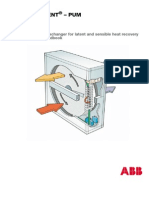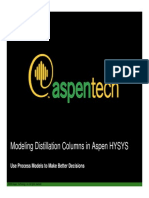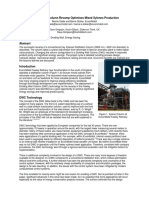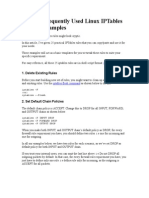Aspen Shell & Tube Exchanger Study Guide: Exam Prep For Users
Aspen Shell & Tube Exchanger Study Guide: Exam Prep For Users
Uploaded by
MiguelÁngelHernándezOsorioCopyright:
Available Formats
Aspen Shell & Tube Exchanger Study Guide: Exam Prep For Users
Aspen Shell & Tube Exchanger Study Guide: Exam Prep For Users
Uploaded by
MiguelÁngelHernándezOsorioOriginal Title
Copyright
Available Formats
Share this document
Did you find this document useful?
Is this content inappropriate?
Copyright:
Available Formats
Aspen Shell & Tube Exchanger Study Guide: Exam Prep For Users
Aspen Shell & Tube Exchanger Study Guide: Exam Prep For Users
Uploaded by
MiguelÁngelHernándezOsorioCopyright:
Available Formats
Aspen Shell & Tube Exchanger Study
Guide
Exam Prep for Users
Aspen® Knowledge Learn. Apply. Succeed.
Who can take this certification?
The certification is a must-have for any user new to
Aspen Exchanger Design & Rating who has taken
Design and Rate a Shell and Tube Heat Exchanger
(EHX101).
Step 1: Take Class: Design and Rate a Shell and Tube Heat Exchanger
(EHX101) – 2 Days
AspenTech offers a variety of delivery methods in which you can take training.
• Register for public training (face to face or virtual)
Exam Scope for Design
• Register for private training (face to face or virtual)
and Rate a Shell and
• Subscribe to eLearning (on-demand)
Tube Heat Exchanger
(EHX101)
Step 2: Review Scope and Objectives
□ Calculation Models
□ Physical Properties This guide contains 100% coverage of all objectives for the Aspen Shell
□ Geometry & Tube Exchanger certification exam. You can use as both a study tool
□ Results and an on-the job reference.
□ Documentation
Step 3: Take Aspen Shell & Tube Exchanger certification exam
Grading The total time for the certification exam is four hours.
Grade Weight
Multiple choice
40%
questions
Lab task 60%
Total 100%
AspenTech
Call | Email | Chat
© 2021 Aspen Technology, Inc. All rights reserved. 1
TECHNICAL
SCOPE COMPETENCY OBJECTIVE
CONTENT
Calculation General Options Identify the available calculation modes
Modes
Identify where in the UI to select/change the calculation mode
Design mode Identify required inputs and expected outputs
Identify the two options for optimization (area or cost)
Define area ratio
Identify key variables considered in the design algorithm (area
ratio, pressure ratio, TEMA limits for rho-V2 and unsupported
length, vibration)
Identify how to enter process and/or geometry limits
Rating Mode Identify required inputs and expected outputs
Interpret area ratio results
Simulation Mode Identify required inputs and expected outputs
Interpret area ratio results
Find Fouling Identify required inputs and expected outputs
Interpret area ratio results
Overall Identify, for a given problem statement, the applicable calculation
mode, and the required input
Physical Physical Property Identify the different physical property packages options (B-JAC,
Properties Packages COMThermo, Aspen Properties, User Specified)
Property Methods Identify categories of property methods (Ideal, EOS, Activity
models) and general application for each
TECHNICAL
SCOPE COMPETENCY OBJECTIVE
CONTENT
© 2021 Aspen Technology, Inc. All rights reserved. 2
Physical Overall Explain the importance of the temperature range/# of points and
Properties pressure levels in physical properties calculation
Identify, for a given problem statement, the applicable physical
property package, and the appropriate property method
Geometry Basic configuration Identify key options that are always selected by the user (not
changed by EDR): TEMA type, hot fluid location, exchanger
orientation, baffle type, etc.
Identify applications for different shell types
Identify arguments to be considered during hot fluid location
selection (high pressure, hazardous fluid, fouling)
Geometry Recognize key geometry (tube ID/OD, shell ID/OD, # of tubes, #
passes, tube pitch, pattern, tube length, baffle type)
Recognize the types of tube layout available
Identify EDR standards for geometry (TEMA, ASME, most common
commercial dimensions)
Identify Non-TEMA configurations (double pipe, hairpin)
Construction Design Specifications Recognize the Design codes available
Specifications
Results Warning/Messages Identify the types of messages displayed by EDR and its importance
(errors, warnings, advisories, notes)
Interpret, given a particular file, the error/warning messages
Develop, given your previous interpretation, some modifications
that could potentially help fixing the error/warning messages
TEMA sheet Recognize, from a list of outputs, which could be found in the
TEMA sheet
Explain how to export TEMA sheet to Excel
Thermal Interpret, for a given simulation, area ratio value, heat transfer
area of the unit
© 2021 Aspen Technology, Inc. All rights reserved. 3
TECHNICAL
SCOPE COMPETENCY OBJECTIVE
CONTENT
Results Thermal State, for a given simulation, the effective mean temperature
difference
State, for a given simulation, the tube side and shell side overall
film coefficients
Interpret, given a simulation, which side represents the greater
contribution to the overall HTC
State, for a given simulation, the tube side and shell side resistance
distribution
Interpret, given a simulation, how much the fouling resistances
from both sides contributing to the heat transfer resistance
Results Hydraulic Identify the three contributions to the overall pressure
drop (frictional, momentum change, gravitational)
State, given a simulation, pressure drop on each side
Identify, given the same file, which pressure drop mechanism has
the greater contribution on each side
Identify, given the same file, which part of the exchanger
represents the greater contribution to pressure on each side
Identify on which part of the exchanger the highest velocity is
achieved on each side
Identify, given a simulation, if there are Rho-V2 TEMA limits
violations
Mechanical
Identify the two types of vibration analyzed and reported by EDR
Identify, within a provided list, which factors or mechanisms can
influence the vibration assessment
Analyze, the vibration assessment in a given simulation and
develop a plan to fix such vibration issues
© 2021 Aspen Technology, Inc. All rights reserved. 4
TECHNICAL
SCOPE COMPETENCY OBJECTIVE
CONTENT
Results Mechanical Identify, within the tube layout of a given simulation, the tubes
analyzed for the vibration assessment
Identify, given a simulation, a geometry parameter calculated by
the program (instead of being specified)
State, given a simulation, the total cost of the unit (all shells)
Documentation Help Guide State the definition of a given concept by searching it in the Help
Guide
© 2021 Aspen Technology, Inc. All rights reserved. 5
You might also like
- Major Project ReportDocument33 pagesMajor Project ReportSuraj mourya100% (2)
- SUS P205 Aspen Plus GreenH ACU Study GuideDocument3 pagesSUS P205 Aspen Plus GreenH ACU Study Guidegorgs.marieNo ratings yet
- Aspen PLUS: Exam Prep For Certified UsersDocument14 pagesAspen PLUS: Exam Prep For Certified UsersKhaledAhmed100% (1)
- At-05197 Hysys Study GuideDocument22 pagesAt-05197 Hysys Study Guidewf4sr4r100% (1)
- Aspen EDR® Heat Exchanger Energy Efficiency Modeling Certification Exam (Copy)Document7 pagesAspen EDR® Heat Exchanger Energy Efficiency Modeling Certification Exam (Copy)ing.usmansaeedNo ratings yet
- Orifice Flow MeterDocument6 pagesOrifice Flow MeterAnand PalNo ratings yet
- Batch 10 - AdvtDocument24 pagesBatch 10 - AdvtsumitNo ratings yet
- Rotary Heat ExchangerDocument32 pagesRotary Heat Exchangerntt_121987No ratings yet
- 2 Flare Net Introduction WorkshopDocument11 pages2 Flare Net Introduction WorkshopAlaeddine AbidNo ratings yet
- Getting Start Hysys UnisimDocument38 pagesGetting Start Hysys UnisimBassem BalghouthiNo ratings yet
- Aspen FLARENET Getting Started PDFDocument62 pagesAspen FLARENET Getting Started PDFPankaj AdhikariNo ratings yet
- A Simple Simulation With ASPEN EDRDocument9 pagesA Simple Simulation With ASPEN EDRgaming jafarNo ratings yet
- Orifice Sizing Using DWSIMDocument17 pagesOrifice Sizing Using DWSIMmigNo ratings yet
- Aspen MUSE GettingstartedDocument27 pagesAspen MUSE GettingstartedSurya Budi WidagdoNo ratings yet
- P&ID Walkdown Testing Procedure:: How To Use This DocumentDocument3 pagesP&ID Walkdown Testing Procedure:: How To Use This DocumentBasha Yazn AnjakNo ratings yet
- Spreadsheet Distillation PDFDocument8 pagesSpreadsheet Distillation PDFArunkumarNo ratings yet
- Webinar FAQ - Shell and Tube Heat ExchangersDocument8 pagesWebinar FAQ - Shell and Tube Heat Exchangersrameshkarthik810No ratings yet
- HYSYS Stream Reported A Quick Guide 1732800596Document25 pagesHYSYS Stream Reported A Quick Guide 1732800596petrolink2021No ratings yet
- Accurate Prediction of Tower ReliefDocument5 pagesAccurate Prediction of Tower Reliefmajope1966No ratings yet
- DistillationWebSeminar PDFDocument30 pagesDistillationWebSeminar PDFKetan ParikhNo ratings yet
- HTRI 20case 20study 20shellsideDocument2 pagesHTRI 20case 20study 20shellsideHarish KaushikNo ratings yet
- Control Valve Sizing ASPEN HYSYS 1722434841Document9 pagesControl Valve Sizing ASPEN HYSYS 1722434841Warda YousafNo ratings yet
- Korf Hydraulic ReportDocument10 pagesKorf Hydraulic ReportMuthuKumar ArunachalamNo ratings yet
- Hotkey HysysDocument24 pagesHotkey HysysgermanaponteNo ratings yet
- 521 TiDocument4 pages521 Tisa.somaNo ratings yet
- Distillation Column Control Design Using Steady StateDocument18 pagesDistillation Column Control Design Using Steady Stateb95504048No ratings yet
- HSR 1.63 (For HYSYS V10.0)Document4 pagesHSR 1.63 (For HYSYS V10.0)Ba Jun Thối0% (1)
- Solution 109431 - What Does Increment DP More Than 10% of Inlet MeanDocument2 pagesSolution 109431 - What Does Increment DP More Than 10% of Inlet MeanEdgar ChaconNo ratings yet
- FlaresDocument18 pagesFlaresEric WanNo ratings yet
- CHEN 4470 - Process Design Practice: Dr. Mario Richard Eden Department of Chemical Engineering Auburn UniversityDocument23 pagesCHEN 4470 - Process Design Practice: Dr. Mario Richard Eden Department of Chemical Engineering Auburn UniversityRachele PiovanelliNo ratings yet
- PIPEPHASE Getting Started GuideDocument134 pagesPIPEPHASE Getting Started Guidepolaris44No ratings yet
- Manual Entry of Properties For 2-Phase VL Mixtures With Aspen EDRDocument7 pagesManual Entry of Properties For 2-Phase VL Mixtures With Aspen EDRMuhammad NaeemNo ratings yet
- Divided Wall Column 496Document6 pagesDivided Wall Column 496GeorgeNo ratings yet
- Limiting Conditions - Reflux Ratios: Total Reflux Ratio, D 0, L/V 1, and L/D Minimum Reflux Ratio, (L/D)Document11 pagesLimiting Conditions - Reflux Ratios: Total Reflux Ratio, D 0, L/V 1, and L/D Minimum Reflux Ratio, (L/D)Arvind SinghNo ratings yet
- Design CriteriaDocument6 pagesDesign CriteriaAllyssa Jane ErcillaNo ratings yet
- Chemical & Process Technology: Simple Method For Compressor Settle Out Using HYSYSDocument3 pagesChemical & Process Technology: Simple Method For Compressor Settle Out Using HYSYSJhnteller1100% (1)
- Hydraulic Analysis Report - B1 - INT-1Document42 pagesHydraulic Analysis Report - B1 - INT-1sunnypawar1996No ratings yet
- Steam Ejector HysysDocument4 pagesSteam Ejector Hysysfluto100% (1)
- Aspen Tutorial PDFDocument62 pagesAspen Tutorial PDFCristian Mateo Ovalle Cifuentes100% (1)
- Introduction To HYSYS Plant2.4 Bubble Dew & FlashesDocument7 pagesIntroduction To HYSYS Plant2.4 Bubble Dew & FlashesMagdyNo ratings yet
- Hetran TEMA Sheet ExamplesDocument39 pagesHetran TEMA Sheet ExamplesAriesNo ratings yet
- Pipesys TutorialDocument62 pagesPipesys TutorialNatalia Prieto JimenezNo ratings yet
- S-138777-Activated Energy Analysis Jump Start GuideDocument18 pagesS-138777-Activated Energy Analysis Jump Start Guidegion_ro401No ratings yet
- Process Designing of Breather ValvesDocument15 pagesProcess Designing of Breather ValvesGuglielmoNo ratings yet
- Vacuum: Technologies Technical Reference GuideDocument1 pageVacuum: Technologies Technical Reference GuideCalNo ratings yet
- The Overflash in Distillation TowerDocument2 pagesThe Overflash in Distillation TowerDhanny MiharjaNo ratings yet
- Design of High Pressure Vessels Using Aspen HYSYS Blowdown AnalysisDocument11 pagesDesign of High Pressure Vessels Using Aspen HYSYS Blowdown AnalysisPIDNo ratings yet
- 11-4567 JS Activation Tifs RefreshDocument14 pages11-4567 JS Activation Tifs Refreshedgardiaz5519No ratings yet
- Depressuring - Dynamics: Blowdown-Fire: ConnectionsDocument4 pagesDepressuring - Dynamics: Blowdown-Fire: ConnectionsNKNo ratings yet
- Guidelines For Changing From Steady State To Dynamic SimulationDocument3 pagesGuidelines For Changing From Steady State To Dynamic SimulationAmit YadavNo ratings yet
- Chemical Engineering 422 Simulation With Hysys: NotesDocument9 pagesChemical Engineering 422 Simulation With Hysys: NotesNoor Ul HaqNo ratings yet
- Study Guide-Aspen Plus BasicsDocument9 pagesStudy Guide-Aspen Plus BasicsRanjani J DeepakNo ratings yet
- Specimen MS - Paper 2 OCR Computer Science GCSEDocument23 pagesSpecimen MS - Paper 2 OCR Computer Science GCSEIntisharNo ratings yet
- Aspen Plus ACU Study GuideDocument38 pagesAspen Plus ACU Study GuideEl Mouatez Messini100% (1)
- AT-05198 - Aspen Plus DM Study Guide PDFDocument15 pagesAT-05198 - Aspen Plus DM Study Guide PDFashraf-84No ratings yet
- FluentDocument30 pagesFluentijaz fazilNo ratings yet
- Aspen HYSYS: Study Guide For CertificationDocument9 pagesAspen HYSYS: Study Guide For CertificationMariana MichelNo ratings yet
- DoeDocument29 pagesDoeNinong Elmal100% (1)
- Week 1 - EIS Rubrics Performance Criteria 2016A SeptDocument2 pagesWeek 1 - EIS Rubrics Performance Criteria 2016A SeptsyafiqfatNo ratings yet
- AT-05200 - PIMS Study GuideDocument8 pagesAT-05200 - PIMS Study GuideAyman FawzyNo ratings yet
- C&R Technologies: Hot Engineering ... Cool SoftwareDocument2 pagesC&R Technologies: Hot Engineering ... Cool SoftwareksvvijNo ratings yet
- BS in ArchitectureDocument6 pagesBS in ArchitectureMoimoi TyNo ratings yet
- PUM-PM-EQM-009 - List Display Functional Location ILH ARF KRMDocument6 pagesPUM-PM-EQM-009 - List Display Functional Location ILH ARF KRMaditya rahimNo ratings yet
- Assignmnet IT404Document2 pagesAssignmnet IT404selfuseacNo ratings yet
- 25 Most Frequently Used Linux IPTables Rules ExamplesDocument8 pages25 Most Frequently Used Linux IPTables Rules ExamplesictnewNo ratings yet
- COACourse Overview SlidesDocument7 pagesCOACourse Overview SlidesYana RomeroNo ratings yet
- NothingDocument3 pagesNothingHảiTrungLêNo ratings yet
- Network Engineer Resume GaneshDocument2 pagesNetwork Engineer Resume GaneshGanesh PatilNo ratings yet
- ESSARP Creative Writing - Regulations and GuidelinesDocument7 pagesESSARP Creative Writing - Regulations and GuidelinesInes RuizNo ratings yet
- Cisco ISE:: Cisco Identity Services EngineDocument7 pagesCisco ISE:: Cisco Identity Services EngineAbdulfattah AssadNo ratings yet
- Lecture 1Document19 pagesLecture 1Blue WhaleNo ratings yet
- User Manual: Downloaded From Manuals Search EngineDocument24 pagesUser Manual: Downloaded From Manuals Search EngineWalNo ratings yet
- DSOOP Class 03Document40 pagesDSOOP Class 03Datta RajendraNo ratings yet
- The Project Success Model V4.0Document31 pagesThe Project Success Model V4.0parta legawaNo ratings yet
- Mongoose: SchemasDocument10 pagesMongoose: SchemasRehan bhattiNo ratings yet
- Practical Introduction To PCI Express With FPGAs - ExtendedDocument77 pagesPractical Introduction To PCI Express With FPGAs - ExtendedNH Hoang XuanNo ratings yet
- CBSE Sample Question Papers For Class 12 English Core 2020Document10 pagesCBSE Sample Question Papers For Class 12 English Core 2020Krishnendu TalukdarNo ratings yet
- QSG So Speaky Black Diamond (Web)Document14 pagesQSG So Speaky Black Diamond (Web)Ramon Toledano CabrerizoNo ratings yet
- NORTEL GSM Principles PDFDocument512 pagesNORTEL GSM Principles PDFKarim Mirak100% (1)
- 02.SAP PP Video Course Content & Materials Detials PDFDocument4 pages02.SAP PP Video Course Content & Materials Detials PDFDhanvirNo ratings yet
- P 05Document38 pagesP 05reza515hei0% (1)
- Syscallx 64Document15 pagesSyscallx 64tommasoNo ratings yet
- Lab 1 OsgDocument12 pagesLab 1 OsgTrình Phạm khánhNo ratings yet
- Technical Know ToDocument9 pagesTechnical Know Topal singhNo ratings yet
- CR 30-X - Chapter 00 - Order List For DocumentationDocument6 pagesCR 30-X - Chapter 00 - Order List For Documentationmedicamust12No ratings yet
- Week 1 PPT 1Document19 pagesWeek 1 PPT 1CHARLS JAYBEE ATILLONo ratings yet
- After Effects: Important ShortcutsDocument1 pageAfter Effects: Important Shortcutshitide7389No ratings yet
- Internship Report FinalDocument35 pagesInternship Report FinalDESSIE FIKIRNo ratings yet
- Diminished Scale Linear Concepts ChartDocument3 pagesDiminished Scale Linear Concepts ChartJazz72100% (1)
























































































